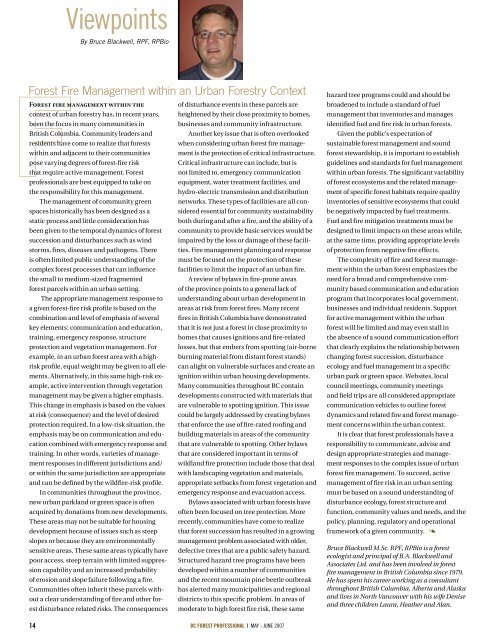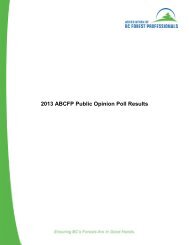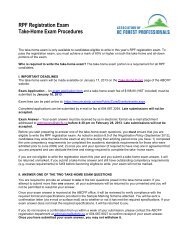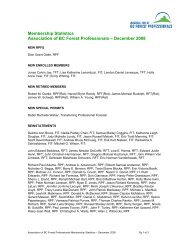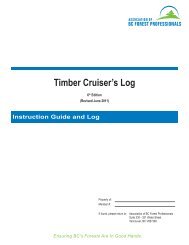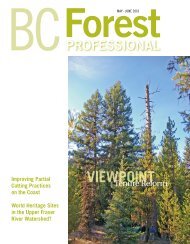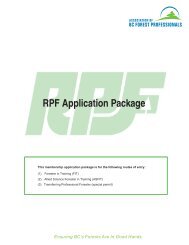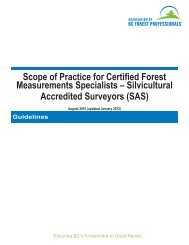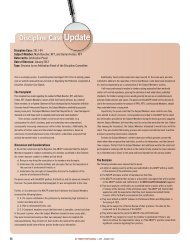T - Association of BC Forest Professionals
T - Association of BC Forest Professionals
T - Association of BC Forest Professionals
You also want an ePaper? Increase the reach of your titles
YUMPU automatically turns print PDFs into web optimized ePapers that Google loves.
Viewpoints<br />
By Bruce Blackwell, RPF, RPBio<br />
F<strong>Forest</strong> fire management within the<br />
<strong>Forest</strong> Fire Management within an Urban <strong>Forest</strong>ry Context<br />
context <strong>of</strong> urban forestry has, in recent years,<br />
been the focus in many communities in<br />
British Columbia. Community leaders and<br />
residents have come to realize that forests<br />
within and adjacent to their communities<br />
pose varying degrees <strong>of</strong> forest-fire risk<br />
that require active management. <strong>Forest</strong><br />
pr<strong>of</strong>essionals are best equipped to take on<br />
the responsibility for this management.<br />
The management <strong>of</strong> community green<br />
spaces historically has been designed as a<br />
static process and little consideration has<br />
been given to the temporal dynamics <strong>of</strong> forest<br />
succession and disturbances such as wind<br />
storms, fires, diseases and pathogens. There<br />
is <strong>of</strong>ten limited public understanding <strong>of</strong> the<br />
complex forest processes that can influence<br />
the small to medium-sized fragmented<br />
forest parcels within an urban setting.<br />
The appropriate management response to<br />
a given forest-fire risk pr<strong>of</strong>ile is based on the<br />
combination and level <strong>of</strong> emphasis <strong>of</strong> several<br />
key elements: communication and education,<br />
training, emergency response, structure<br />
protection and vegetation management. For<br />
example, in an urban forest area with a highrisk<br />
pr<strong>of</strong>ile, equal weight may be given to all elements.<br />
Alternatively, in this same high-risk example,<br />
active intervention through vegetation<br />
management may be given a higher emphasis.<br />
This change in emphasis is based on the values<br />
at risk (consequence) and the level <strong>of</strong> desired<br />
protection required. In a low-risk situation, the<br />
emphasis may be on communication and education<br />
combined with emergency response and<br />
training. In other words, varieties <strong>of</strong> management<br />
responses in different jurisdictions and/<br />
or within the same jurisdiction are appropriate<br />
and can be defined by the wildfire-risk pr<strong>of</strong>ile.<br />
In communities throughout the province,<br />
new urban parkland or green space is <strong>of</strong>ten<br />
acquired by donations from new developments.<br />
These areas may not be suitable for housing<br />
development because <strong>of</strong> issues such as steep<br />
slopes or because they are environmentally<br />
sensitive areas. These same areas typically have<br />
poor access, steep terrain with limited suppression<br />
capability and an increased probability<br />
<strong>of</strong> erosion and slope failure following a fire.<br />
Communities <strong>of</strong>ten inherit these parcels without<br />
a clear understanding <strong>of</strong> fire and other forest<br />
disturbance related risks. The consequences<br />
<strong>of</strong> disturbance events in these parcels are<br />
heightened by their close proximity to homes,<br />
businesses and community infrastructure.<br />
Another key issue that is <strong>of</strong>ten overlooked<br />
when considering urban forest fire management<br />
is the protection <strong>of</strong> critical infrastructure.<br />
Critical infrastructure can include, but is<br />
not limited to, emergency communication<br />
equipment, water treatment facilities, and<br />
hydro-electric transmission and distribution<br />
networks. These types <strong>of</strong> facilities are all considered<br />
essential for community sustainability<br />
both during and after a fire, and the ability <strong>of</strong> a<br />
community to provide basic services would be<br />
impaired by the loss or damage <strong>of</strong> these facilities.<br />
Fire management planning and response<br />
must be focused on the protection <strong>of</strong> these<br />
facilities to limit the impact <strong>of</strong> an urban fire.<br />
A review <strong>of</strong> bylaws in fire-prone areas<br />
<strong>of</strong> the province points to a general lack <strong>of</strong><br />
understanding about urban development in<br />
areas at risk from forest fires. Many recent<br />
fires in British Columbia have demonstrated<br />
that it is not just a forest in close proximity to<br />
homes that causes ignitions and fire-related<br />
losses, but that embers from spotting (air-borne<br />
burning material from distant forest stands)<br />
can alight on vulnerable surfaces and create an<br />
ignition within urban housing developments.<br />
Many communities throughout <strong>BC</strong> contain<br />
developments constructed with materials that<br />
are vulnerable to spotting ignition. This issue<br />
could be largely addressed by creating bylaws<br />
that enforce the use <strong>of</strong> fire-rated ro<strong>of</strong>ing and<br />
building materials in areas <strong>of</strong> the community<br />
that are vulnerable to spotting. Other bylaws<br />
that are considered important in terms <strong>of</strong><br />
wildland fire protection include those that deal<br />
with landscaping vegetation and materials,<br />
appropriate setbacks from forest vegetation and<br />
emergency response and evacuation access.<br />
Bylaws associated with urban forests have<br />
<strong>of</strong>ten been focused on tree protection. More<br />
recently, communities have come to realize<br />
that forest succession has resulted in a growing<br />
management problem associated with older,<br />
defective trees that are a public safety hazard.<br />
Structured hazard tree programs have been<br />
developed within a number <strong>of</strong> communities<br />
and the recent mountain pine beetle outbreak<br />
has alerted many municipalities and regional<br />
districts to this specific problem. In areas <strong>of</strong><br />
moderate to high forest fire risk, these same<br />
14 <strong>BC</strong> FOREST PROFESSIONAL | MAY - JUNE 2007<br />
hazard tree programs could and should be<br />
broadened to include a standard <strong>of</strong> fuel<br />
management that inventories and manages<br />
identified fuel and fire risk in urban forests.<br />
Given the public’s expectation <strong>of</strong><br />
sustainable forest management and sound<br />
forest stewardship, it is important to establish<br />
guidelines and standards for fuel management<br />
within urban forests. The significant variability<br />
<strong>of</strong> forest ecosystems and the related management<br />
<strong>of</strong> specific forest habitats require quality<br />
inventories <strong>of</strong> sensitive ecosystems that could<br />
be negatively impacted by fuel treatments.<br />
Fuel and fire mitigation treatments must be<br />
designed to limit impacts on these areas while,<br />
at the same time, providing appropriate levels<br />
<strong>of</strong> protection from negative fire effects.<br />
The complexity <strong>of</strong> fire and forest management<br />
within the urban forest emphasizes the<br />
need for a broad and comprehensive community<br />
based communication and education<br />
program that incorporates local government,<br />
businesses and individual residents. Support<br />
for active management within the urban<br />
forest will be limited and may even stall in<br />
the absence <strong>of</strong> a sound communication effort<br />
that clearly explains the relationship between<br />
changing forest succession, disturbance<br />
ecology and fuel management in a specific<br />
urban park or green space. Websites, local<br />
council meetings, community meetings<br />
and field trips are all considered appropriate<br />
communication vehicles to outline forest<br />
dynamics and related fire and forest management<br />
concerns within the urban context.<br />
It is clear that forest pr<strong>of</strong>essionals have a<br />
responsibility to communicate, advise and<br />
design appropriate strategies and management<br />
responses to the complex issue <strong>of</strong> urban<br />
forest fire management. To succeed, active<br />
management <strong>of</strong> fire risk in an urban setting<br />
must be based on a sound understanding <strong>of</strong><br />
disturbance ecology, forest structure and<br />
function, community values and needs, and the<br />
policy, planning, regulatory and operational<br />
framework <strong>of</strong> a given community. �<br />
Bruce Blackwell M.Sc. RPF, RPBio is a forest<br />
ecologist and principal <strong>of</strong> B.A. Blackwell and<br />
Associates Ltd. and has been involved in forest<br />
fire management in British Columbia since 1979.<br />
He has spent his career working as a consultant<br />
throughout British Columbia, Alberta and Alaska<br />
and lives in North Vancouver with his wife Denise<br />
and three children Laura, Heather and Alan.


